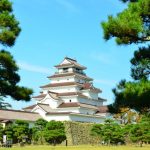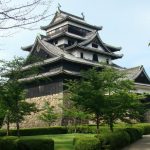Food you should try in Japan – Part 2
We introduced 10 classic Japanese foods (not including sushi or okonomiyaki as everybody knows them) plus three challenging foods in Japan in our article, “Food you should try in Japan – Part 1”.
Now, I’ll introduce how to eat and drink like a local in Japan with some more delightful Japanese foods!
As they say, when in Rome, do as the Romans do, right!! I’m sure that you’d like to have authentic experiences during your Japan holiday and you’re trying to put all of the classic dishes onto a list. But your list might not be enough to fill three meals in a day (plus snacks!!) every day during your holiday!
Here are some hints for how to eat and drink like a local as well as some more food you should try in Japan. (Oh, hi! I’m Emi. I was born and raised in Japan and am a staff member of Japan Explorer….a Japan Expert, so trust me!)
1. Konbini Foods
(コンビニ フード)

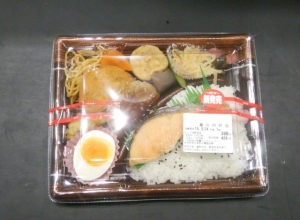
You should definitely try to have some “konbini foods”. What’s “konbini”? It’s an abbreviation of convenience store – “convenie” (Japanese people call it “konbini”). Japanese convenience stores are just that…..super convenient, and you can get almost everything there. There is such a variety of goods and foods. FYI, here is the convenience store guide.
Try some konbini bento or onigiri (rice balls). There’s also sandwiches, salad, hot snacks such as croquette and fried chicken, sweets, soft drinks and alcohol from beer to sake/whisky, and more foods and drinks!
Have some konbini food for lunch or breakfast (and for snacks). The locals definitely head to the konbini for their food and drinks!
Personally, I think the sweets from konbini are also great. Don’t forget to try them!
2. Traditional Japanese Breakfast (和朝食)
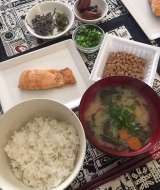
This is commonly served with rice, miso soup, grilled salmon, natto and a raw egg (the last two might be challenging for you)! *In Japan, all eggs are sanitised and given an antiseptic wash before being distributed, so the risk of food poisoning from a raw egg is quite low. (I’d say that it’d be a passion of Japanese people to eat raw egg!! And they will make an extra effort to do so. Haha!)
*A challenge task for you! “Tamago-kake-gohan” (a raw egg on rice, splashed with soy sauce) is a popular way to eat raw egg in Japan which you could try.
3. Gyu-don (牛丼)
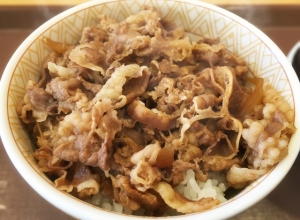
“Gyu” means beef and “don” means bowl in Japanese. “Don” is commonly used to refer to a rice bowl for foods (if you see on some menus “____-don”, it means that something is served on top of rice in a bowl. There are many “don” foods in Japan. i.e. Katsu-don which is a bowl of rice topped with deep-fried port cutlet and cooked egg and vegies also with sauce). Gyu-don, literally “beef rice bowl”, is thinly sliced beef and onion cooked in sweet dashi broth and soy sauce, served over rice in a bowl.
The traditional Japanese breakfast and Gyu-don can be eaten at a Gyu-don chain shop such as Yoshinoya, Sukiya or Matsuya, as well as a teishoku-ya – a casual eatery such as Yayoi-ken or Otoya (they are also chain eateries).
4. Omu-rice (オムライス)
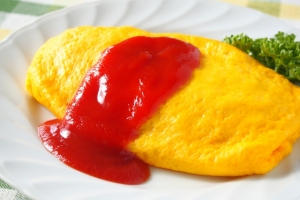
Omu-rice is short for Omelette & Rice. It’s a tomato sauce flavoured fried rice with chicken or minced meat wrapped in an omelette. Tomato sauce or demi-glace sauce is poured on top of it. It’s beloved by men and women of all ages in Japan!
5. Hambagu (Hamburger steak) (ハンバーグ)
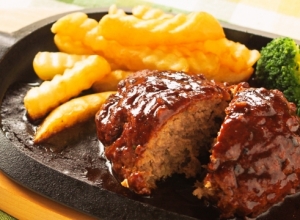
The Japanese hamburger steak is similar to meatloaf. It’s usually cooked with mixed pork and beef mince and it’s grilled or pan-fried. The unique point of a Japanese hamburger steak is that there are many varieties of sauce – stewed hamburger steak, demi-glace sauce, gravy sauce, Tonkatsu sauce, Worcestershire sauce, Japanese-style sauce (it could be dashi flavoured etc.) and more. A cheese hamburger steak would be great to try! Melted cheese inside or on top of a hamburger steak. It’s a very hearty and savoury dish!
6. Doria (ドリア)
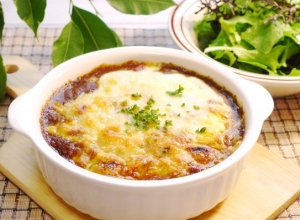
This dish is like a potato gratin but with rice instead of potato. The rice is generally cooked as chicken or seafood pilaf (many restaurants and those cooking at home also prepare a chicken/seafood fried rice with batter, salt, pepper and garlic etc). Béchamel sauce and cheese is spread on top, then it gets baked in the oven. (Pilaf/fried rice and the white sauce can be arranged with various flavours such as tomato sauce, demi-glace sauce and curried pilaf etc).
These three dishes (omu-rice, hambagu and doria) have some similarities with western foods, but they were all originally cooked in Japan as a creative cuisine. After trial and error, they’ve been adapted to suit the taste of Japanese, or as a Japanese-style dish. They can be eaten at a “family restaurant” (a family restaurant is a casual eatery and many of them are chain restaurants such as Gusto, Bikkuri Donkey, Saizeriya, Coco’s and Joyful etc…) and at local eateries. These dishes are also typical Japanese home cooked foods.
Why don’t you participate in a cooking class and to learn how to cook “Omu-rice” from a local? Find a cooking lesson in Japan at a local’s place or studio here!
7. Udon/Soba noodles
(うどん/そば)
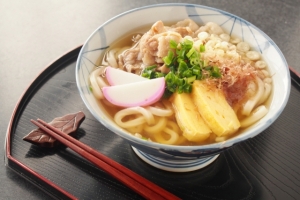
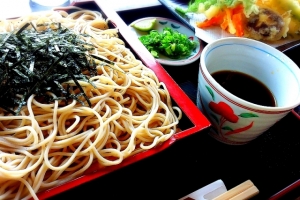
Udon, soba and ramen are the most popular noodle dishes in Japan with udon and soba having a particularly long history. (Ramen is listed in part 1.)
Udon is a thick and chewy noodle. It’s made from wheat flour and eaten with a slightly sweetened dashi broth (as a bowl of noodles or even dipping into the soup).
Soba is well known as buckwheat noodles, literally made from buckwheat flour. However, lots of soba noodles are made from a mix of buckwheat flour and wheat flour. Soba made from 100% buckwheat flour is called “juwari soba” or “towari soba”.
Both udon and soba can be eaten hot or cold. There are lots of toppings for both such as Kitsune udon/soba (cooked tofu on the top), tempura udon/soba etc. It could be tried as “tsuke-men” which is where you dip the noodles into sauce/soup. In the case of soba, generally called “zaru-soba”, the noodles and soup/sauce are served separately, then you eat the noodles dipped into the soup/sauce.
Udon and soba can be eaten at a family restaurant (again), chain eatery Nakau (there you can also have udon and soba as well as “don” dishes), Marugame-Seimen (for Udon – a chain shop), Nadai Fujisoba (for soba – a chain store). Of course, you can try them at a local soba or udon restaurant or even at a noodle stand at a platform in a train station while you are waiting for a train (this will be a sensational travel experience for you, I believe!)
A surprising fact for you – (please don’t hate them!). When Japanese people eat noodles (especially udon, soba and ramen), they make (big) slurping sounds!! They don’t make noises when they have spaghetti though! There are some unique table manners in Japan and many taboos including “do not make a noise when you eat”, however it seems that noodles are the exception. Many Japanese (including me) don’t know the exact reason for making slurping sounds when you eat udon, soba and ramen. Some say that you would enjoy the aroma and taste of the noodles more by doing so. Some say you show the chef your appreciation or enjoyment of the noodles by doing this. If you can, don’t hesitate to make slurping sounds when you eat udon, soba or ramen! Well, anyway it’s up to you, just eat in a way that’s comfortable for you. But you will hear that many locals slurping their noodles, so please don’t hate them! It’s just our culture.
8. Kashi-pan/Sozai-pan
(菓子パン/惣菜パン)
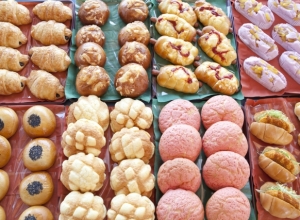

Pan means bread in Japan. It’s said the origin of the word “pan” is from the Portuguese “Pão” (it came from Christian missions). (There are so many adopted words in Japan. Pan is one of them.)
Kashi-pan is a sweet bread, like a pastry in Australia but it’s not made from piecrust. There are also pastry types of kashi-pan, but they are more like filled and stuffed with whipped cream/custard cream with fruits or chocolates etc… into a round (or oval) shaped sweetened and softened bread.
Sozai-pan is a savoury version of kashi-pan. The fillings or toppings are commonly savoury foods. Why don’t you try… a yakisoba-pan, a curry-pan or a corn-mayo pan?
There are so many bakeries in Japan (in or near the train stations as well), you can pop into one of them and try some! You could get these breads (kashi-pan and sozai-pan) at a konbini too.
9. Ton-jiru/Miso-shiru
(豚汁/味噌汁)
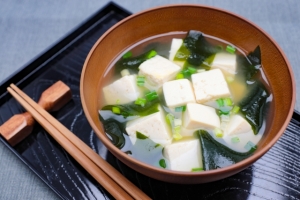

Shiru or jiru means soup in Japanese. Miso-shiru (miso soup) is not eaten as a main dish in Japan. Most of the time it’s served on the side with a rice dish. It’s made of miso (soy beans) paste and dashi (fish stock). You can have a variety of different toppings. Simple miso soup can be made with just wakame seaweed and spring onion (and/or tofu).
Ton-jiru is one of the hearty miso soups which is filled with thinly sliced pork, root vegetables such as potatoes, carrots, onions, gobo (burdock root) and spring onion on the top.
If you try a traditional Japanese breakfast, then having miso soup at the same time is the best way and an authentic way to have it! (If you order as a set menu, then miso soup is usually included.)
10. Takoyaki/Tako-kara
(たこ焼き/タコ唐)

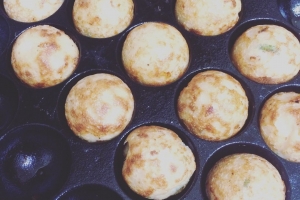

Tako means octopus in Japanese. Yes, I understand that some people still can’t believe that people eat octopus! But think about it… you would eat squid as calamari, wouldn’t you? Octopus is similar to squid. It doesn’t have a strong or peculiar taste or smell and the texture is also very similar to squid. So, if you’ve already eaten squid, you might be fine with octopus, I presume.
Takoyaki is cooked (boiled and diced into small pieces) octopus covered in a pancake-like ball (but not sweet) with savoury takoyaki sauce (which tastes like a mix of BBQ sauce and Worcestershire sauce), mayonnaise, aonori (dried nori, seaweed flakes) and bonito flakes on the top. Takoyaki is famous as a soul food of Osaka (there are so many takoyaki stands on the streets in Osaka). Even if you are not in Osaka, there are some takoyaki shops around, like the chain shops Gindako, or try a local takoyaki shop.
Tako-kara (tako karaage) is deep-fried octopus which is marinated in soy sauce and garlic.
Both can be tried at an Izakaya, Japanese pub. I’ll introduce and recommend more Izakaya foods in “Food you should try in Japan Part 3”!
Enjoy your Japanese food experience in Japan at local restaurants, eateries, even learning from locals how to cook and how to eat! That’ll provide you with a fantastic memory and an authentic Japanese food experience of your Japan holiday.
Here you could find a cooking class or two with local teachers.
Itadakimasu!!!




